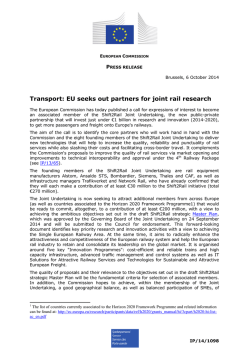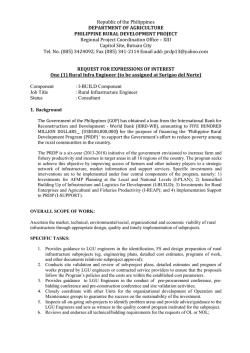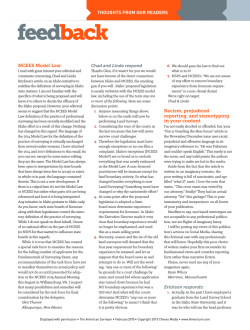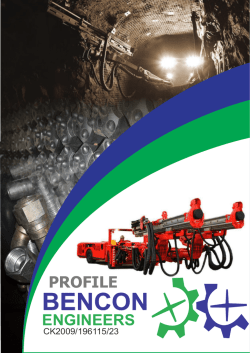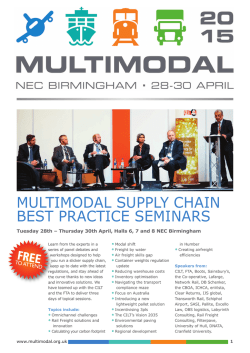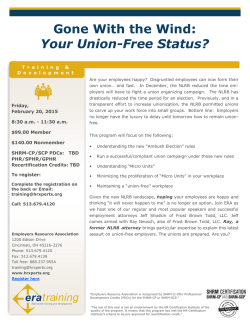
The Sweett way
Rail Employment The Sweett way Gerard Fitzpatrick heads up rail, the fastest growing sector team at independent commercial consultant Sweett Group. He tells Bernadette Ballantyne about “getting things done” in the growing infrastructure market. With 1575 employees in 18 countries the business has grown hugely since its founding in 1928. Which parts are growing today and why? The infrastructure sector is anticipated to have the biggest growth over the next five years, particularly energy and transport. Major growth was initially triggered through successfully securing a major framework with Transport for London. This, coupled with our continued work for Network Rail and commercial services delivery at Heathrow and Gatwick airports, have seen the transport sector in particular go from strength to strength. Rail is the fastest growing sector team in Sweett Group with 75 individuals working on rail related projects in the UK. Gerard Fitzpatrick – “I am a firm believer in allowing people to do the type of work they enjoy doing” Which current projects best represent your division in Sweett Group? Over the last 20 years we have helped our clients deliver over £30bn worth of complex, challenging rail and infrastructure projects in the UK and overseas. Three current commissions that stand out are London Bridge which is going to make a significant difference to people’s journeys, as well as reaping regeneration benefits; London Overground where we are sole provider of cost management on Transport for London’s £330m capacity improvement programme; and our recent involvement at Blackfriars redevelopment project. What are your biggest challenges / opportunities at the moment? There are some major opportunities coming to the market in the next few years and we have been really pleased with our growth in the transport team regionally. Historically, our focus was on London but we have seen continued expansion in our teams in the north and south west on projects such as Bristol Rapid Transit, Halton Sidings and a major park and ride scheme in York. We see this expansion progressing and are pleased to have recently been successful on the Network Rail Scotland Framework where we are one of two key providers. 30 Infrastructure Intelligence | January 2015 Sweett Group has helped clients deliver £30bn in projects over 20 years. With over 20 years experience in multidisciplinary high value rail projects you have built a reputation for “getting things done”, tell us more about your career. Prior to joining Sweett Group I was at Mott MacDonald where I was project director leading commercial management activity for rail projects in the south of the UK. Before this I was at Balfour Beatty Rail which I joined in 1995 as a principal quantity surveyor. My major projects experience includes being the commercial manager on the NLRIP; working as a major change procurement manager for the East London Line; commercial manager to close out Blackfriars station redevelopment with Network Rail; and 13 years on major UK track renewal programmes. Where did you get started? My career started as a trainee quantity surveyor working for a formwork and concrete subcontractor, CJ O’Shea & Co Ltd. I learned from the sharp end of the importance of cash flow management and the intricacies of getting paid by main contractors in the 1980s. I then moved into general construction as a senior quantity surveyor. I was lucky enough to achieve my MRICS status through day release and this type of learning approach is something I am really happy to help the next generation of people with, who will steer construction forward into the digital era. How are you supporting the next generation of people into the company? One of the key achievements this year is the implementation of the Sweett Group Apprenticeship scheme. This scheme is designed to attract school leavers to a career in our industry, above other professions. The apprenticeship program provides a career path for these school leavers, with a 2 year NVQ Level 3, followed by the organisation supporting the transition into a HNC and degree program. Ultimately it is a career path towards Chartership. Looking to the future what sort of people will find a happy home at Sweett Group? I don’t think there is a typical “Sweett” person but I am a firm believer in allowing people to do the type of work that they enjoy doing, as this results in a better product. Our culture is strongly focused on enabling our people to develop by pursuing further qualifications and attending external seminars. At present, 20% of our staff are studying for qualifications. In November, we were delighted to get a 100% success rate for those completing their APC programme, becoming members of RICS. I am proud that my team consists of many skilled professionals, 70% are fully chartered professionals. This is an excellent advertisement for my people. Securing talent to deliver in 2015 Employers must think big and be creative in their resource planning says Matchtech operations director Grahame Carter. A s the fastest growing economy in the G7 the past year has seen growing optimism about the strength of the UK’s recovery. The Organisation for Economic Co-operation and Development predicts that this will continue forecasting GDP growth of 2.7% in 2015 and 2.5% in 2016. Significant public sector investment on projects, notably infrastructure, is also providing a driver for growth. In his Autumn Statement, the Chancellor announced £466bn in spending as part of the National Infrastructure Plan. This includes £15bn for the strategic road network, £5.8bn for local road maintenance and £2.3bn for flood defences. This, in addition to projects such as Crossrail and HS2, amounts to a sizable investment in the UK’s infrastructure. While on the surface this is a reason for the infrastructure sector to feel confident in the future, the upcoming General Election on 7th May 2015 does bring with it considerable uncertainty. Few projects are completely safe from a change in governing party. HS2 has cross-party buy-in, but more recent announcements, such as the £15bn road plan, may not get off the ground at all. This uncertainty makes planning difficult for many businesses in the sector, but regardless of what happens in May, there is wide recognition that the UK’s infrastructure network must be improved to support economic growth. As a result, demand for experienced engineers is expected to continue to grow, regardless of where the investment comes from. And herein lies the rub. While the sector is experiencing strong growth, it has a dwindling pool of engineering talent to draw on to build the infrastructure being commissioned. In Matchtech’s latest Confidence Index, we surveyed more than 500 engineers in the infrastructure sector asking what policy initiatives they would like to see in the political parties’ manifestos to help drive growth. Two fifths (39%) said increasing the level of infrastructure investment as a foundation for future economic growth was the number one priority initiative, followed by greater investment in STEM (Science, Technology, Engineering, and Mathematics) apprenticeship schemes, also chosen by 39%, and a clear strategy for future investment in UK energy infrastructure and clarity on the energy mix chosen by 36%. Engineers want to see investment in infrastructure continue but also recognise they have to see a parallel investment in skills and training if the UK is to build and maintain the talent it needs. Many current projects are already suffering from growing skills shortages. There is recognition among politicians that action has to be taken to build and maintain the STEM skills base in the UK, more recently seen in Ed Miliband’s statement that a Labour government will seek to create an extra 400,000 engineers by 2020 by encouraging young people to study STEM subjects and expanding apprenticeship schemes. However, while useful, solutions such as this risk being too long term in scope and need to be coupled with incentives that encourage graduates and qualified engineers to choose a career in the sector now and stay committed to it. Attracting new people into the industry is not beneficial if you continue to lose more experienced staff. For those currently working in engineering, there is likely to be a rich choice of jobs in the infrastructure sector in 2015. While employers will reap the rewards of the much needed investment, they will also be feeling anxious about delivering what they need to when there is such fierce competition for experienced engineers. This is where resource planning will form an integral part of their success in 2015. Employers must think ‘big’ when addressing their future recruitment needs, looking to engineers from other sectors and thinking about how their skills can be transferred and utilised. Flexibility on the part of employers would also help to reduce the skills shortage. Greater efforts to accommodate working parents, and help long-distance commuters to maintain a better work-life balance (such as home working) would enable more engineers to provide a wider range of roles. Providing a working environment that helps those approaching retirement or recently retired is also essential. These experienced workers provide an invaluable source of information that can be drawn upon to help train less experienced engineers, in preparation for the workload ahead. By thinking creatively, solutions can be found to the recruitment pressures that employers face this year, and when they meet those needs they will succeed, in what is a very exciting time for the infrastructure sector. Want advice? You can contact Grahame at [email protected] or on January 2015 | Infrastructure Intelligence 31
© Copyright 2025

